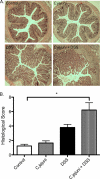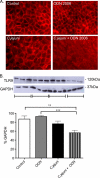Campylobacter jejuni disrupts protective Toll-like receptor 9 signaling in colonic epithelial cells and increases the severity of dextran sulfate sodium-induced colitis in mice
- PMID: 22311925
- PMCID: PMC3318425
- DOI: 10.1128/IAI.06066-11
Campylobacter jejuni disrupts protective Toll-like receptor 9 signaling in colonic epithelial cells and increases the severity of dextran sulfate sodium-induced colitis in mice
Abstract
Inflammatory bowel disease (IBD) is characterized by chronic intestinal inflammation associated with a dysregulated immune response to commensal bacteria in susceptible individuals. The relapse of IBD may occur following an infection with Campylobacter jejuni. Apical epithelial Toll-like receptor 9 (TLR9) activation by bacterial DNA is reported to maintain colonic homeostasis. We investigated whether a prior C. jejuni infection disrupts epithelial TLR9 signaling and increases the severity of disease in a model of mild dextran sulfate sodium (DSS) colitis in mice. In a further attempt to identify mechanisms, T84 monolayers were treated with C. jejuni followed by a TLR9 agonist. Transepithelial resistance (TER) and dextran flux across confluent monolayers were monitored. Immunohistochemistry, Western blotting, and flow cytometry were used to examine TLR9 expression. Mice colonized by C. jejuni lacked any detectable pathology; however, in response to low levels of DSS, mice previously exposed to C. jejuni exhibited significantly reduced weight gain and increased occult blood and histological damage scores. Infected mice treated with DSS also demonstrated a significant reduction in levels of the anti-inflammatory cytokine interleukin-25. In vitro studies indicated that apical application of a TLR9 agonist enhances intestinal epithelial barrier function and that this response is lost in C. jejuni-infected monolayers. Furthermore, infected cells secreted significantly more CXCL8 following the basolateral application of a TLR9 agonist. Surface TLR9 expression was reduced in C. jejuni-infected monolayers subsequently exposed to a TLR9 agonist. In conclusion, infection by C. jejuni disrupts TLR9-induced reinforcement of the intestinal epithelial barrier, and colonization by C. jejuni increases the severity of mild DSS colitis.
Figures









References
-
- Bleich A, et al. 2009. CpG motifs of bacterial DNA exert protective effects in mouse models of IBD by antigen-independent tolerance induction. Gastroenterology 136:278–287 - PubMed
-
- Cario E. 2008. Barrier-protective function of intestinal epithelial Toll-like receptor 2. Mucosal Immunol. 1(Suppl 1):S62–S66 - PubMed
-
- Cario E, Gerken G, Podolsky DK. 2007. Toll-like receptor 2 controls mucosal inflammation by regulating epithelial barrier function. Gastroenterology 132:1359–1374 - PubMed
-
- Cario E, Gerken G, Podolsky DK. 2004. Toll-like receptor 2 enhances ZO-1-associated intestinal epithelial barrier integrity via protein kinase C. Gastroenterology 127:224–238 - PubMed
Publication types
MeSH terms
Substances
Grants and funding
LinkOut - more resources
Full Text Sources
Medical
Molecular Biology Databases
Research Materials

